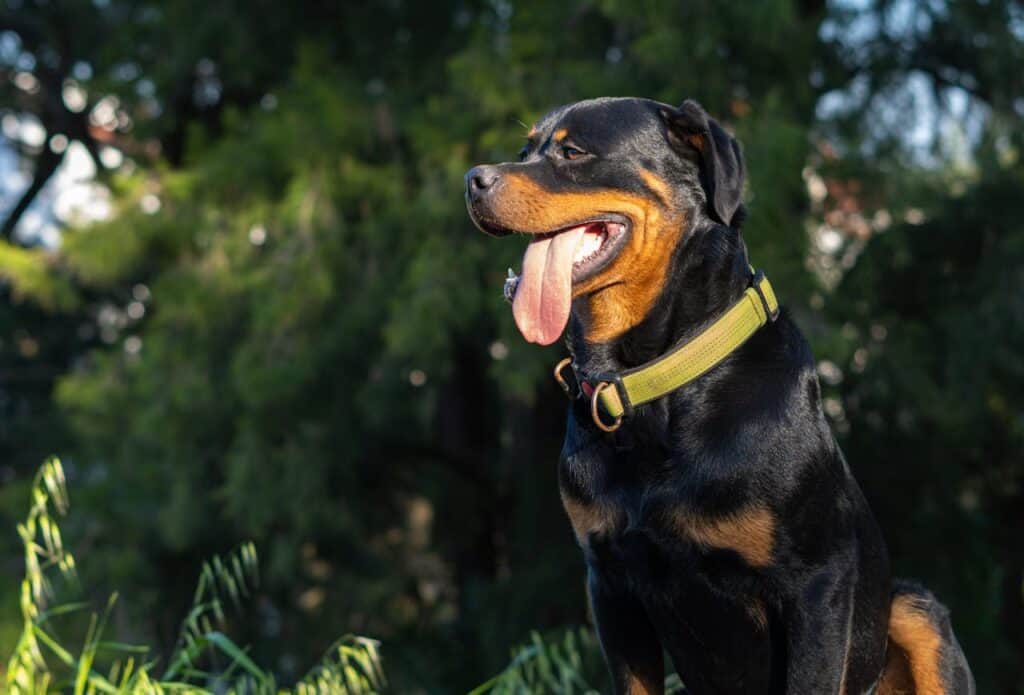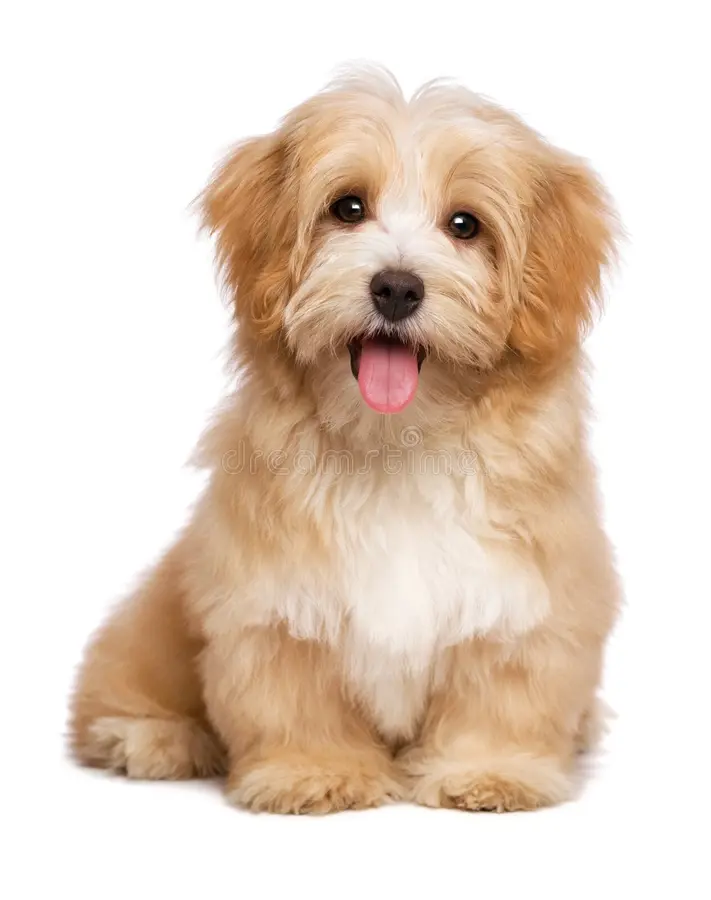1. Introduction
The Rottweiler is a breed that exudes power and confidence, yet beneath their robust exterior lies a loyal and affectionate companion. Known for their protective instincts and remarkable strength, Rottweilers have earned their place as one of the most reliable and versatile breeds. Whether serving as a guard dog, a working dog, or a family companion, the Rottweiler consistently proves to be a dog of great character and capability. With their deep loyalty and strong bonds with their families, it’s no wonder they are often regarded as man’s best friend.
Key Characteristics and Traits
Rottweilers are large, muscular dogs that typically weigh between 80-135 pounds (36-61 kg) and stand 22-27 inches (56-69 cm) tall at the shoulder. Their powerful build and broad chest give them an imposing presence, yet their dark, expressive eyes reveal a calm and thoughtful nature. The breed is known for its distinctive black coat with rust-colored markings, which add to their striking appearance.
Beyond their physical attributes, Rottweilers are highly intelligent and trainable. They are known for their keen understanding of their environment and their ability to make quick decisions, making them excellent working dogs. Their loyalty and protective nature make them exceptional guardians, but they also have a playful and affectionate side that endears them to their families. With proper training and socialization, Rottweilers are gentle giants who thrive in loving homes where they can be a true part of the family.
2. Scientific Insights of the Rottweiler
Cognitive Abilities and Intelligence
Rottweilers are often praised for their intelligence, and scientific studies back up this reputation. According to Dr. Stanley Coren, a leading expert in canine psychology, Rottweilers rank among the top ten most intelligent dog breeds in terms of obedience and working intelligence. This means they are not only quick learners but also capable of understanding complex tasks and commands. In tests of problem-solving and adaptability, Rottweilers have consistently shown that they can think independently and make decisions based on their surroundings.
One study published in the Journal of Veterinary Behavior examined the cognitive abilities of Rottweilers in various working roles, including search and rescue and police work. The study found that Rottweilers excelled in tasks requiring both physical strength and mental acuity, demonstrating their ability to process information quickly and respond appropriately. This cognitive flexibility makes Rottweilers valuable in roles that demand both intelligence and brawn.
Detection Skills and Olfactory Research
While Rottweilers are not as commonly used for detection work as some other breeds, their olfactory abilities should not be underestimated. Research conducted at the University of Helsinki found that Rottweilers possess a highly developed sense of smell, which can be effectively utilized in tracking and detection tasks. In the study, Rottweilers were trained to detect specific scents, such as explosives and narcotics, with a high degree of accuracy.
Their strong work ethic and focus also contribute to their effectiveness in detection roles. Rottweilers are known for their determination and persistence, traits that are invaluable in tasks that require prolonged concentration. Although they may not be the first choice for every detection task, Rottweilers can perform exceptionally well in roles that require both physical strength and sharp olfactory senses.
Behavioral Genetics and Temperament
The temperament of the Rottweiler is a product of careful breeding and genetics. Selective breeding has emphasized traits such as loyalty, protectiveness, and confidence, all of which are hallmarks of the breed. Studies on canine behavioral genetics, such as those conducted by the Max Planck Institute for Evolutionary Anthropology, have shown that Rottweilers possess genetic markers associated with courage, sociability, and a strong bond with their human family members.
These genetic predispositions make Rottweilers naturally inclined to protect their families and property, but they also need proper training and socialization to ensure these traits are expressed positively. A well-bred and well-socialized Rottweiler will be confident, calm, and composed, making them excellent companions and guardians. However, without proper guidance, their natural protectiveness can become excessive, underscoring the importance of responsible ownership.
Role in Medical Therapy and Assistance
Rottweilers have also found a place in the field of medical therapy and assistance, where their calm demeanor and strong bonds with humans make them effective therapy dogs. A study published in the Journal of Psychiatric Research explored the impact of therapy dogs, including Rottweilers, on individuals with anxiety and depression. The study found that interactions with Rottweilers significantly reduced symptoms of anxiety and improved overall emotional well-being.
In addition to therapy work, Rottweilers have been successfully trained as service dogs for individuals with physical disabilities. Their strength and intelligence allow them to perform tasks such as retrieving objects, opening doors, and providing physical support. While they may not be as commonly used as some other breeds in these roles, Rottweilers’ loyalty and willingness to work make them excellent candidates for assistance work when matched with the right handler.
3. History and Origin
Origin of the Rottweiler
The Rottweiler’s history dates back to the Roman Empire, where they were used as herding and guard dogs. The ancestors of the Rottweiler marched with Roman legions as they conquered Europe, driving cattle and protecting the troops. These dogs were the progenitors of the Rottweiler, valued for their strength, endurance, and protective instincts.
As the Romans established outposts in what is now Germany, these dogs were crossed with local breeds, leading to the development of the Rottweiler. The breed’s name is derived from the town of Rottweil in southern Germany, where they were used extensively by butchers to herd livestock and pull carts loaded with meat. Rottweilers were known as “Rottweil butchers’ dogs” due to their work in the town’s bustling meat markets.
Historical Roles and Significance
Throughout history, Rottweilers have been prized for their versatility and reliability. In addition to their work with butchers, they were also used as guard dogs, protecting homes, farms, and businesses. Their ability to work independently and make quick decisions made them invaluable in these roles. Rottweilers were known for their courage and tenacity, traits that are still evident in the breed today.
During the early 20th century, the advent of industrialization reduced the demand for working dogs like the Rottweiler, and the breed’s numbers began to decline. However, Rottweilers found a new role in police and military work, where their strength, intelligence, and loyalty were highly valued. The breed’s resurgence in popularity can be attributed to their success in these roles, as well as their suitability as family guardians.
Today, Rottweilers continue to serve in various capacities, from police and military work to search and rescue and therapy. Their adaptability and strong work ethic have ensured their place as one of the most respected and reliable breeds in the world.

4. Physical Characteristics
Size and Weight of the Rottweiler
Rottweilers are a large and powerful breed, with males typically weighing between 95-135 pounds (43-61 kg) and standing 24-27 inches (61-69 cm) tall at the shoulder. Females are slightly smaller, weighing 80-100 pounds (36-45 kg) and standing 22-25 inches (56-63 cm) tall. Their muscular build and broad chest give them an imposing appearance, but they move with a surprising grace and agility for a dog of their size.
Coat Type and Color
The Rottweiler’s coat is short, dense, and straight, with a glossy appearance that highlights their muscular physique. The coat is black with distinct rust-colored markings on the face, chest, legs, and underside of the tail. These markings are a defining characteristic of the breed and are one of the features that make Rottweilers instantly recognizable.
The coat is relatively low-maintenance, requiring regular brushing to remove loose hair and keep it looking its best. Despite its short length, the coat provides good protection against the elements, though Rottweilers may require additional warmth in extremely cold weather.
Distinctive Features
In addition to their coat, Rottweilers have several other distinctive features that set them apart from other breeds. Their broad head, with a well-defined stop (the point where the forehead meets the muzzle), gives them a powerful and confident expression. The muzzle is strong and square, with a black nose and tightly fitting lips. Their eyes are dark and almond-shaped, conveying a calm and confident demeanor.
Rottweilers have a strong, muscular neck and a deep chest, contributing to their overall powerful build. Their tails are typically docked, though this practice is becoming less common in some countries. When left natural, the tail is carried in a slight curve and adds to the breed’s balanced and athletic appearance.
Speed and Agility
Despite their size, Rottweilers are remarkably agile and can reach speeds of up to 25 miles per hour (40 km per hour). This speed, combined with their strength, makes them effective working dogs in roles that require both power and agility. Whether chasing down a suspect or navigating an obstacle course, Rottweilers move with a combination of strength and grace that is impressive to watch.
Their agility is not just limited to speed; Rottweilers are also known for their ability to change direction quickly and navigate difficult terrain. This makes them valuable in search and rescue operations, where they may need to cover rough ground to locate missing persons. In competitive sports like agility trials, Rottweilers often excel, showcasing their physical abilities and mental focus.
5. Types of Rottweilers
German vs. American Rottweilers
Rottweilers can be broadly categorized into two types: German and American. The German Rottweiler is typically bred with a focus on working ability and adherence to the breed standard set by the Allgemeiner Deutscher Rottweiler Klub (ADRK). German Rottweilers are known for their robust build, strong bones, and correct temperament. They are often used in working roles, such as police and military work, and are prized for their strength and endurance.
The American Rottweiler, on the other hand, is often bred with a focus on appearance and conformation to the American Kennel Club (AKC) breed standard. American Rottweilers tend to have a slightly lighter build and a more refined appearance compared to their German counterparts. While they still retain the working abilities of the breed, American Rottweilers are more commonly found in the show ring or as companion animals.
Both types have their strengths, and the choice between a German and American Rottweiler will depend on the owner’s needs and preferences. Those looking for a working dog may prefer a German Rottweiler, while those interested in showing or companionship may opt for an American Rottweiler.
Working Line vs. Show Line
Within the breed, there are also distinctions between working line and show line Rottweilers. Working line Rottweilers are bred primarily for their abilities as working dogs, with a focus on traits like intelligence, drive, and physical endurance. These dogs are often used in roles that require high levels of training and physical stamina, such as protection work, search and rescue, and competitive obedience.
Show line Rottweilers, on the other hand, are bred with a focus on appearance and conformation to breed standards. While they still retain the intelligence and trainability of the breed, show line Rottweilers are more commonly found in the show ring or as companion animals. They tend to have a slightly more refined appearance, with a focus on elegance and grace in their movements.
Both types have their strengths, and the choice between a working line and show line Rottweiler will depend on the owner’s goals. Those looking for a family pet may prefer a show line Rottweiler, while those interested in working or competitive sports may opt for a working line Rottweiler.
6. Temperament and Personality
General Behavior and Traits of the Rottweiler
Rottweilers are known for their loyal and protective nature, traits that have been carefully cultivated through selective breeding. They are incredibly devoted to their families and will go to great lengths to protect them from perceived threats. This loyalty, combined with their intelligence, makes them excellent guard dogs and protectors.
Despite their reputation as fierce protectors, Rottweilers are also known for their affectionate and gentle nature with their families. They are highly social dogs that thrive on companionship and interaction with their human family members. Rottweilers are known for forming strong bonds with their owners and are often described as being “velcro dogs” because they love to be close to their people.
Rottweilers are also highly intelligent and trainable, making them excellent candidates for various roles, from family pets to working dogs. They are quick learners and respond well to positive reinforcement training methods. However, their intelligence also means they can become bored easily, so they need plenty of mental stimulation and exercise to keep them happy and well-behaved.
Interaction with Family, Children, and Other Pets
Rottweilers are known for their strong bonds with their families, including children. They are protective yet gentle, making them excellent family pets when properly trained and socialized. However, due to their size and strength, it is essential to supervise interactions between Rottweilers and small children to ensure safety. Rottweilers are generally patient and tolerant with children, but they may become protective if they sense that their family is threatened.
When it comes to other pets, Rottweilers can get along well with other dogs and even cats, provided they are introduced properly and socialized from a young age. However, their strong prey drive means they may be inclined to chase smaller animals, so early socialization and training are crucial to ensure harmonious relationships with other pets in the household.
Rottweilers are also known for their loyalty and devotion to their owners. They thrive on companionship and can become anxious or depressed if left alone for extended periods. This makes them best suited for families or individuals who can spend a lot of time with them and include them in daily activities.
Socialization Needs
Socialization is critical for Rottweilers, as it helps them develop into well-rounded and confident adults. Exposing them to various people, environments, and other animals from a young age will ensure they grow up to be adaptable and well-behaved dogs. Rottweilers that are not properly socialized may become overly protective or anxious, leading to behavioral issues.
Socialization should be a continuous process throughout the dog’s life, with regular exposure to new experiences. This will help them remain confident and composed in various situations, whether at home, in public, or in new environments. Proper socialization also helps prevent aggression and ensures that Rottweilers can interact appropriately with people and other animals.
7. Health and Common Diseases
Typical Lifespan of the Rottweiler
Rottweilers have a typical lifespan of 8-10 years, which is slightly shorter than average for a breed of their size. However, their lifespan can be influenced by factors such as genetics, diet, exercise, and access to regular veterinary care. With proper care and attention, some Rottweilers can live healthy lives well into their teens.
Common Health Issues and Genetic Conditions
Like all breeds, Rottweilers are prone to specific health issues, some of which are hereditary. One of the most common genetic conditions affecting Rottweilers is hip and elbow dysplasia, a malformation of the hip or elbow joint that can lead to arthritis and mobility issues. This condition can be managed with proper care, but it is crucial to obtain a Rottweiler from a reputable breeder who tests for dysplasia in their breeding stock.
Another common issue is aortic stenosis, a congenital heart defect that can lead to heart failure if left untreated. Regular cardiac screenings are essential for early detection and management of this condition. Rottweilers are also prone to osteosarcoma (bone cancer), a particularly aggressive form of cancer that often affects the long bones of the legs.
Rottweilers are also at risk for bloat, a life-threatening condition where the stomach fills with gas and twists, cutting off blood flow. This condition requires immediate veterinary attention and is more common in large, deep-chested breeds like the Rottweiler. Regular check-ups with a veterinarian, a balanced diet, and proper exercise can help manage and prevent some of these health issues.
8. Care and Grooming
Grooming Needs of the Rottweiler
Rottweilers have relatively low grooming needs due to their short, dense coat. They shed year-round, but regular brushing, ideally once or twice a week, can help manage shedding and keep their coat looking shiny and healthy. A rubber grooming mitt or a soft bristle brush is usually sufficient to remove loose hair and distribute natural oils across the coat.
Bathing should be done as needed, typically every few months, unless the dog gets particularly dirty. Over-bathing can strip the coat of its natural oils, leading to dry skin. Regular ear cleaning, teeth brushing, and nail trimming are also essential parts of a Rottweiler’s grooming routine. Because of their short coat, Rottweilers are prone to skin conditions, so it’s important to monitor their skin for any signs of irritation or infection.
Rottweilers’ nails should be trimmed regularly to prevent them from becoming too long, which can cause discomfort or even lead to injury. If you’re not comfortable trimming your dog’s nails yourself, a professional groomer or veterinarian can do it for you. Regular teeth brushing is also important for maintaining good oral health and preventing dental issues.
Exercise Requirements
Rottweilers are an active breed that requires regular exercise to maintain their physical and mental health. They need at least 1-2 hours of exercise daily, which can include walks, playtime, and mental stimulation activities. Due to their intelligence, they also thrive on tasks that challenge their minds, such as obedience training, agility courses, or puzzle toys.
Exercise is not just about physical activity; it also helps prevent boredom, which can lead to destructive behaviors. Rottweilers that do not receive enough exercise may become anxious, frustrated, or develop behavioral problems. Providing them with adequate physical and mental stimulation is essential for a happy and well-balanced dog.
In addition to daily walks, Rottweilers enjoy activities that allow them to use their natural abilities, such as running, hiking, or playing fetch. They are also excellent candidates for canine sports like agility, obedience, and protection work. These activities provide both physical exercise and mental stimulation, helping to keep your Rottweiler healthy and happy.
9. Hypoallergenic Status
Rottweilers are not considered hypoallergenic. Their short coat does shed, which can trigger allergies in sensitive individuals. The dander (dead skin cells) they produce is a common allergen. While regular grooming can help manage shedding and reduce dander, it will not eliminate allergens entirely.
If you or a family member suffers from dog allergies, it is essential to spend time around Rottweilers before bringing one into your home to ensure that the breed does not cause significant allergic reactions.

10. Nutrition Requirements
Dietary Needs of the Rottweiler
The dietary needs of a Rottweiler will vary based on their age, activity level, and health. Generally, they require a high-quality, balanced diet that provides all the essential nutrients. Protein is particularly important for this breed, given their muscular build and high energy levels. Look
for dog food that lists meat as the first ingredient and avoid foods with excessive fillers.
For puppies, a diet formulated for large-breed puppies is recommended, as it helps support their rapid growth without causing joint issues. Adult Rottweilers should be fed a diet that maintains their weight and meets their energy needs, while senior Rottweilers may benefit from a diet that supports joint health and mobility.
Recommended Food and Supplements
In addition to high-quality dog food, some Rottweilers may benefit from supplements. Glucosamine and chondroitin are commonly recommended for joint health, particularly in breeds prone to hip dysplasia. Omega-3 fatty acids, found in fish oil, can help maintain a healthy coat and skin, as well as support cognitive function.
Always consult with a veterinarian before introducing supplements to ensure they are appropriate for your dog’s specific needs. Fresh water should always be available, and treats should be given in moderation to prevent obesity.
It’s also important to monitor your Rottweiler’s weight and adjust their diet as needed to prevent obesity, which can exacerbate health issues like hip dysplasia and heart disease. Regular check-ups with your veterinarian can help ensure that your dog is getting the right nutrition for their age and activity level.
11. Training and Obedience
Trainability of the Rottweiler
Rottweilers are highly trainable due to their intelligence and eagerness to please. They excel in obedience training and can learn complex commands and tasks with relative ease. Early training is essential to ensure they develop into well-mannered adults, and their training should be consistent and positive.
Positive reinforcement techniques, such as using treats, praise, and play, are particularly effective with Rottweilers. They respond well to clear and consistent commands and thrive in an environment where they are mentally stimulated and challenged. However, it’s important to establish yourself as a confident and consistent leader, as Rottweilers can be strong-willed and may try to assert dominance if they sense a lack of leadership.
Common Training Techniques
Training should begin with basic commands such as sit, stay, come, and heel. Once these are mastered, more advanced training can be introduced, including agility, tracking, or protection work, depending on the dog’s role. Rottweilers also benefit from socialization training, where they learn to interact with various people, animals, and environments.
Crate training is often recommended for Rottweilers, as it provides them with a safe space and can help with housebreaking. Leash training is also important, as Rottweilers are strong dogs that need to be taught to walk calmly on a leash. Teaching your Rottweiler to walk on a loose leash from a young age can prevent pulling and other leash-related issues.
Tips for Successful Training
Consistency is key when training a Rottweiler. Training sessions should be short but frequent, keeping the dog engaged and preventing boredom. Patience and positive reinforcement will yield the best results, as harsh methods can lead to fear or anxiety in the dog.
It’s also important to make training a part of daily life. Incorporate commands into regular activities, such as having the dog sit before meals or stay before going for a walk. This helps reinforce training and ensures the dog remains obedient in various situations.
12. Work and Activities
Activities or Jobs That the Rottweiler Excels In
Rottweilers are incredibly versatile and excel in a wide range of activities and jobs. They are commonly used in police and military work, where their intelligence, strength, and loyalty make them ideal for tasks such as tracking, apprehension, and detection. Their keen sense of smell also makes them valuable in search and rescue missions, where they can locate missing persons in challenging environments.
In addition to professional work, Rottweilers excel in various dog sports, such as agility, obedience, and herding trials. These activities provide both physical exercise and mental stimulation, helping to keep the dog healthy and happy. Their agility and speed make them particularly well-suited for sports like agility and obedience, where they can showcase their impressive physical and mental abilities.
Examples of Competitive Sports, Therapy Work, and Search and Rescue
Rottweilers are frequent competitors in agility trials, where their speed and agility are on full display. They navigate obstacle courses with precision and speed, showcasing their physical prowess and trainability. In obedience trials, Rottweilers demonstrate their ability to follow complex commands with accuracy, earning high marks for their performance.
In therapy work, Rottweilers provide comfort and support to individuals in hospitals, nursing homes, and rehabilitation centers. Their calm demeanor and strong bond with humans make them effective therapy dogs, helping to improve the emotional well-being of those they visit.
In search and rescue, Rottweilers are trained to locate missing persons in a variety of environments, from urban areas to wilderness. Their speed, agility, and keen sense of smell make them invaluable in these missions, often saving lives in the process.
13. Behavioral Issues
Common Behavioral Issues
While Rottweilers are generally well-behaved and obedient, they can develop behavioral issues if not properly trained or socialized. One common issue is separation anxiety, which can occur if the dog becomes too attached to their owner and is left alone for extended periods. This can lead to destructive behaviors, such as chewing or excessive barking.
Another issue is aggression, which can manifest if the dog is not properly socialized or feels threatened. Rottweilers are protective by nature, and if not trained to discern between real and perceived threats, they may become overly aggressive towards strangers or other animals.
Managing and Correcting Behavioral Problems
Addressing behavioral issues in Rottweilers requires patience and consistency. For separation anxiety, providing the dog with mental stimulation, such as puzzle toys or interactive games, can help alleviate boredom and anxiety. Gradual desensitization to being alone, combined with positive reinforcement, can also help reduce anxiety.
Aggression can be managed through proper socialization and training. Introducing the dog to various people, animals, and environments from a young age will help them learn to interact appropriately. If aggression becomes a significant issue, working with a professional dog trainer or behaviorist may be necessary to correct the behavior.
Regular exercise and mental stimulation are also crucial in preventing and managing behavioral issues. A well-exercised and mentally challenged Rottweiler is less likely to develop negative behaviors. Ensuring that your Rottweiler receives plenty of exercise, training, and attention can help prevent behavioral problems and ensure a happy, well-adjusted dog.
14. Ideal Owners and Families
Type of Owners Best Suited for the Rottweiler
Rottweilers are best suited for owners who lead active lifestyles and have the time and energy to dedicate to their dog’s training and exercise needs. They require a strong, confident owner who can provide consistent leadership and guidance. First-time dog owners may find the breed challenging due to their intelligence and energy levels, so experience with dogs is often beneficial.
Rottweilers thrive in homes where they can be an integral part of the family. They are loyal and affectionate dogs that form strong bonds with their owners, making them excellent companions for those who can meet their needs. However, their high energy levels and need for mental stimulation mean they may not be the best choice for everyone.
Compatibility with Families, Singles, Older People, etc.
Rottweilers are highly adaptable and can thrive in various living situations, whether with families, singles, or older people. They are particularly well-suited for families with children, as they are protective yet gentle. However, their size and strength mean they may not be the best choice for households with very young children or older individuals unless proper supervision and training are in place.
For singles or older people, Rottweilers can be excellent companions, provided they receive adequate exercise and mental stimulation. They are loyal and devoted dogs that form strong bonds with their owners, making them excellent companions for those who can meet their needs.
Rottweilers are also known for their loyalty and devotion to their owners. They thrive on companionship and can become anxious or depressed if left alone for extended periods. This makes them best suited for families or individuals who can spend a lot of time with them and include them in daily activities.
Living Conditions
Rottweilers can adapt to various living conditions, from apartments to homes with large yards. However, they require regular exercise and mental stimulation, so access to outdoor space or daily walks is essential. They are not well-suited to being left alone for long periods, as they thrive on companionship and interaction with their owners.
In homes with yards, it is important to have secure fencing, as Rottweilers are strong and agile and may try to escape if bored or anxious. They can adapt to indoor living, but regular outdoor activity is crucial to prevent boredom and associated behavioral issues.
15. Adaptability
Adaptability to Different Environments
Rottweilers are highly adaptable dogs that can thrive in various environments, from rural areas to urban settings. Their intelligence and trainability make them capable of adjusting to new situations and environments with relative ease. However, they require regular mental and physical stimulation to prevent boredom and ensure their well-being.
In urban environments, Rottweilers may need more structured exercise routines, such as daily walks or visits to dog parks, to ensure they remain physically active. In rural areas, they may have more opportunities for free play and exploration, which can help satisfy their need for exercise and mental engagement.
Rottweilers are also known for their loyalty and devotion to their owners. They thrive on companionship and can become anxious or depressed if left alone for extended periods. This makes them best suited for families or individuals who can spend a lot of time with them and include them in daily activities.
Adjustments to Lifestyle Changes
Rottweilers can adjust to lifestyle changes, such as moving to a new home or the arrival of a new family member, as long
as their basic needs for exercise, mental stimulation, and companionship are met. Introducing changes gradually and maintaining a consistent routine can help ease the transition and prevent stress or anxiety in the dog.
Their adaptability also extends to changes in their role within the family, such as shifting from a working dog to a family companion. With proper training and socialization, Rottweilers can successfully navigate these transitions and continue to thrive in their new roles.

16. Famous Rottweilers
Notable Rottweilers in History, Movies, or Public Life
Rottweilers have been celebrated in various roles, from working dogs to movie stars. One of the most famous Rottweilers in history is “Carl,” the beloved pet in the Good Dog, Carl series of children’s books by Alexandra Day. Carl’s gentle and protective nature has made him a favorite character among children and parents alike.
In popular culture, Rottweilers have appeared in numerous films and television shows, often portrayed as fierce protectors or loyal companions. One notable example is the Rottweiler in the 1978 horror film The Omen, where the breed’s powerful presence was used to evoke a sense of danger and foreboding.
Rottweilers have also served in various public roles, including as police and military dogs. During World War I, Rottweilers were used by the German army for various tasks, including guarding, message delivery, and pulling carts. Today, Rottweilers continue to serve in various capacities, from police work to search and rescue, thanks to their strong work ethic and loyalty.
17. Summary
Summary of Key Points
The Rottweiler is a versatile and loyal breed known for its intelligence, strength, and adaptability. Originating in Germany, the breed was developed for herding and guarding livestock but quickly gained recognition for its ability to excel in various roles, from police and military work to family companionship. Rottweilers are large, powerful dogs with a short, dense coat and distinctive rust-colored markings.
Rottweilers require regular exercise, mental stimulation, and socialization to thrive. They are highly trainable and excel in various activities, from obedience and agility to search and rescue. While they are prone to certain health issues, such as hip dysplasia and bloat, proper care and attention can help them live healthy, fulfilling lives.
Whether as working dogs or beloved family pets, Rottweilers have earned their place as one of the most respected and admired dog breeds in the world. Their loyalty, intelligence, and versatility make them a truly exceptional breed.
This article is brought to you by Our World of Dogs. Explore more dog breeds and find out how our dog boarding services can benefit your furry friend!



